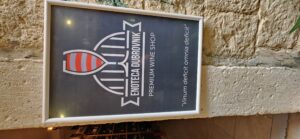With the Covid-19 pandemic fading away (but not gone) many of us are taking vacations again. There are some trips for the explicit purpose of wine tasting, in which days are spent visiting wineries, getting to know the different varietals produced and enjoying being around the vineyards. But sometimes vacationing is just to see friends and family and to take in the sights, in cities rather than in the country.
If your travel plans are leading you to Antarctica or the Sahara, there’s not much local wine to enjoy. But almost anywhere else in the world, in North America or overseas, there is wine made nearby wherever you go. You may not have the time to go to wineries, as we did not during our brief stay in Dubrovnik, but that doesn’t mean you can’t learn a lot about the wines they make wherever you are going.
Here are some tips to add a wine tasting adventure to any vacation.
- Do a little planning before you go. A simple Google search on “Best wine bars in…” will give you a head start. So will a search on “Favorite wines in…” In the latter case, you should refer to the region, not the specific destination to which you are headed. “Favorite wines” in France, for example, won’t help. But if you’re headed to Lyon, for example, a quick look at a map will tell you that Beaujolais and the Northern Rhône are close enough that you’ll know what to look for on wine lists.
A place to learn about Croatian wine. The Latin at the bottom of the sign means “Not enough wine, not enough of anything”
- Visit an enoteca. Which is just a wine shop that offers a degustation, which is a fancy word for a tasting. We found one in Dubrovnik, where the owner was pleased to introduce interested visitors to the history, geography and, of course, the taste of Croatian wines. Over the years, we’ve done the same thing in Paris, Rome, Sydney, San Francisco and other places. There’s bound to be a place to try wines anywhere you might go.
- Take a food tour. This is also something we’ve learned to love in our travels. A guide – hopefully, a knowledgeable guide – takes you around to places where they serve local food specialties and often the wines that pair well with them. We were once on such a tour and all that was offered was one small glass. On a recent food tour in Rome, wine was served in carafes on the table, white and red, for everyone to help themselves. When we ordered another, our guide said that only the first glass was included. We assured her that we had bought ourselves some wine many times before and had no problem to do so again that day.
- Take advantage of where you are. We don’t suggest wine for breakfast, but a glass (maybe two) at lunch, aperitif, dinner and even for a nightcap isn’t a bad idea. Hey, you’re on vacation, so you’ll probably want to indulge a bit anyway. We’re just suggesting that focus on learning about the local wines. Never order the same wine twice, so that you get as broad an exposure to local wines as possible in a short time. If there are two of you, share tastes and double your learning. Of course, be careful about how much you drink if you’re going to get behind the wheel of a car.











